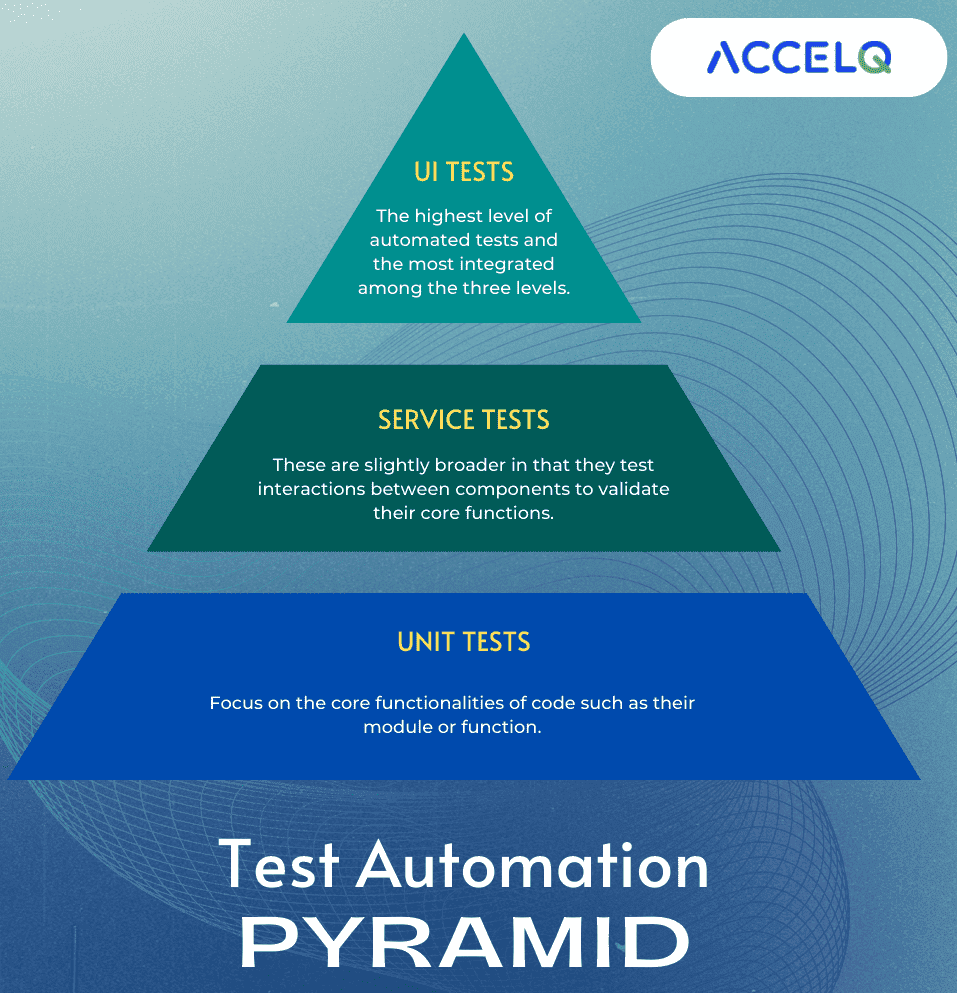What is Test Automation Pyramid? How To Use It in Agile Software Development?

“Test Pyramid,” in general, works to group tests into different categories (levels) based on their granularities (i.e., core functions). These levels define the tests’ quantity, quality, complexity, and execution expertise. Altogether, the idea is to represent a hierarchy that a team of testers should follow when designing, executing and evaluating tests as they iterate through large projects.
As for agile software development, the test automation pyramid helps find the right balance in executing automated tests. However, this pyramid is not a fixed structure and can adapt to the team’s current and expected needs.
All considered, this article serves as a brief introduction to the what is test automation pyramid and how it benefits agile development.
What is Test Automation Pyramid
Originally proposed by the founder of Scrum Alliance, Mike Cohn, the test pyramid illustrates the test execution priorities. It defines three levels of automated tests: unit tests, service tests, and UI tests.

UI Tests
These tests are the highest level of automated tests, testing the user experience or interaction with interfaces. In this case, they could include either user-provided or a pre-programmed test script.
As illustrated below, the unit tests are the most isolated. Contrarily, the UI tests are the most integrated. The three levels capture the test priorities and can help achieve a balance in test coverage and efficiency.
Service tests
These are slightly broader in that they test interactions between components to validate their core functions.
Unit Tests
These tests correspond to the lowest level with the highest granularity in tests. These tests focus on the core functionalities of an individual piece of code, such as a function or module.
SUGGESTED READ - Test Automation Framework: Definition, Types, Pros, and Cons
Modern-day Considerations for Test Automation Pyramid
Customize the Overly-Simplistic Nature of the Test Pyramid
The Automated testing pyramid applied to agile development is ideal for large-scale testing incorporating many different technologies. Therefore, it must be fine-tuned with the team, project, and technology infrastructure for it to be valuable. In other words, the team must adjust the pyramid’s granularity levels relative to the operational environment.
Don’t Take the Level Segregation Literally
The modern-day frameworks allow running unit tests for the UI. As a result, test priorities helping achieve the right coverage and efficiency take center stage. Hence, the division between unit, service, and UI levels should be a mere guideline, not strict segregation.
Do more with Test Automation
Discover more ways to add ‘low-code no-code‘ test automation in your workflows

How to Use Test Automation Pyramid in Agile Software Development?
The agile manifesto principles – collaboration, sustainability, reuse, security, scalability, and user-centricity – strongly recommend a shift in the test priority. The agile manifesto emphasizes the need to reduce time-to-market and improve product quality with the help of test automation. Consequently, teams should run tests at the unit, service, and UI levels before releasing a feature to production.
By all means, agile principles lay the foundation for continuous delivery and the DevOps practice. Moreover, when considering the dynamism of PWAs and mobile apps, test automation is key to:
- Swiftly refactoring code
- Testing cross-platform functionality
- Deploying in multiple environments without manual retesting
- Measuring performance in each environment to prevent regressions and meet micro-services standards.
- Detecting bugs early and frequently in a project cycle (i.e., earlier than with manual testing).
- Ensuring a project’s ongoing stability and quality.
The use of the test automation pyramid helps achieve all this by effectively directing the automated test strategy.
In fact, without test automation, manual setup will take effort and time that can endanger the project’s progress. One example could be testing and fixing UI bugs concerning multiple screen sizes.
Looking Forward with Agile Test Automation Pyramid
Agile development uses a test automation pyramid to improve overall quality. The pyramid’s three levels (unit, service, and UI) exploit the strengths of test automation by capturing and emphasizing key aspects of testing. More profoundly, an agile test pyramid:
Lowers the Probability of Heading to a Wasteful Route
A test portfolio’s structure strongly influences the efficiency of software delivery. As a rule, agile teams perform constant planning, tracking, and review. The test pyramid keeps the test automation strategy in line with the project goals, not allowing the team to lose sight of its progress.
Paves the Way for Consumer-Driven Contract Tests (CDC Tests)
The CDC and ATDD (acceptance test-driven development) methods already consider the test pyramid and its levels. As an outcome, CDC tests validate the system’s core functions and help the in-house team decipher what consumers expect.
Balances the Test Coverage and Effort Levels
As mentioned above, the test pyramid captures the test priorities. This capability is vital for agile teams that tend to run away from the project goals and target excessive coverage. Contrarily, it also caters to those teams that over-emphasize regression testing or do not have a test automation strategy. In either case, the test pyramid helps balance automated testing efforts with the project’s priority and underlying software risks.
Allows for a Wider Test Automation Strategy and API Coverage
As mentioned above, the test pyramid is not a fixed structure. It can adapt to specific environments. As a result, it allows for diversity in the range of automated tests. Teams can run unit tests for UI and assert that the application works properly. This move decreases the project’s time to market. Plus, it avoids the cost of manual testing in production environments.
Reduces Silos
Agile software development creates cross-functional teams that work on the project end-to-end. The power of cross-functional collaboration is incomparable, particularly in the case of test automation. For instance, UI tests help teams collaborate with their QA counterparts. Altogether, diverse groups can create a broader test strategy and validate code for cross-functional purposes.
The Bottom Line
In summary, the test automation pyramid is a resource that helps agile teams create a profound test strategy. It enables diverse stakeholders to gain control over test automation and track the project’s progress.
Moreover, it encourages consumer-facing testing techniques and reduces the likelihood of wasting efforts when developing the product. Overall, the pyramid helps establish a foundation for agile testing and the associated productivity gains.
Geosley Andrades
Director, Product Evangelist at ACCELQ
Geosley is a Test Automation Evangelist and Community builder at ACCELQ. Being passionate about continuous learning, Geosley helps ACCELQ with innovative solutions to transform test automation to be simpler, more reliable, and sustainable for the real world.
Discover More
 Reasons Why Test Automation Projects Fail
Reasons Why Test Automation Projects Fail
Reasons Why Test Automation Projects Fail
 Challenges in Achieving In-Sprint Automation and Solutions
Challenges in Achieving In-Sprint Automation and Solutions


